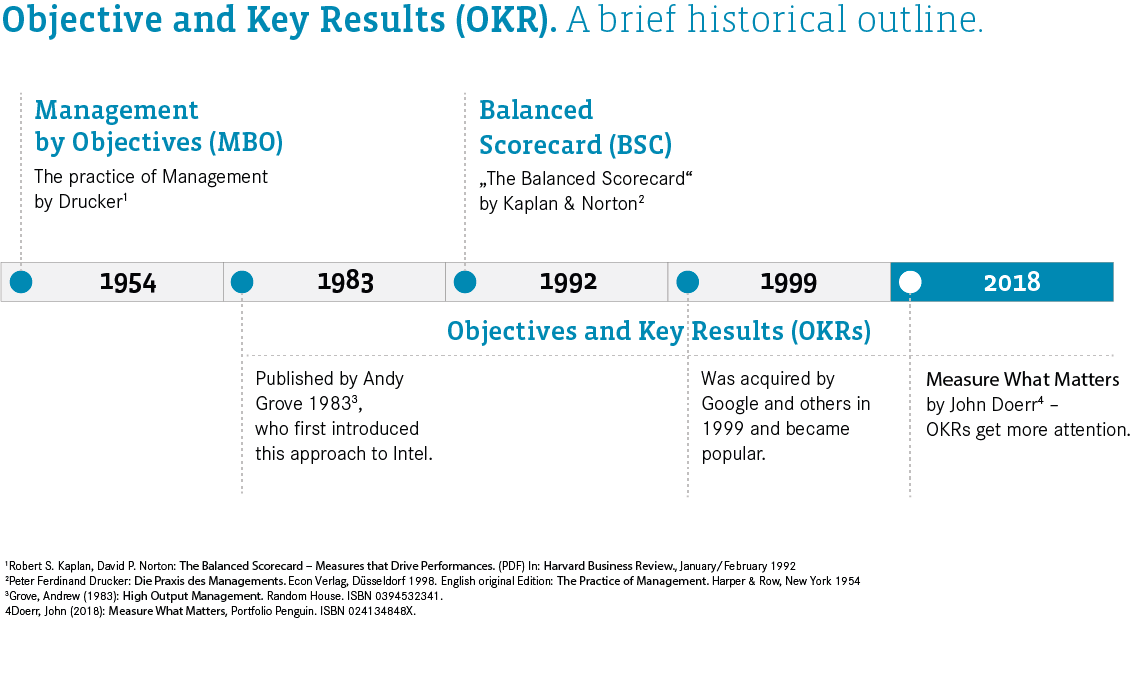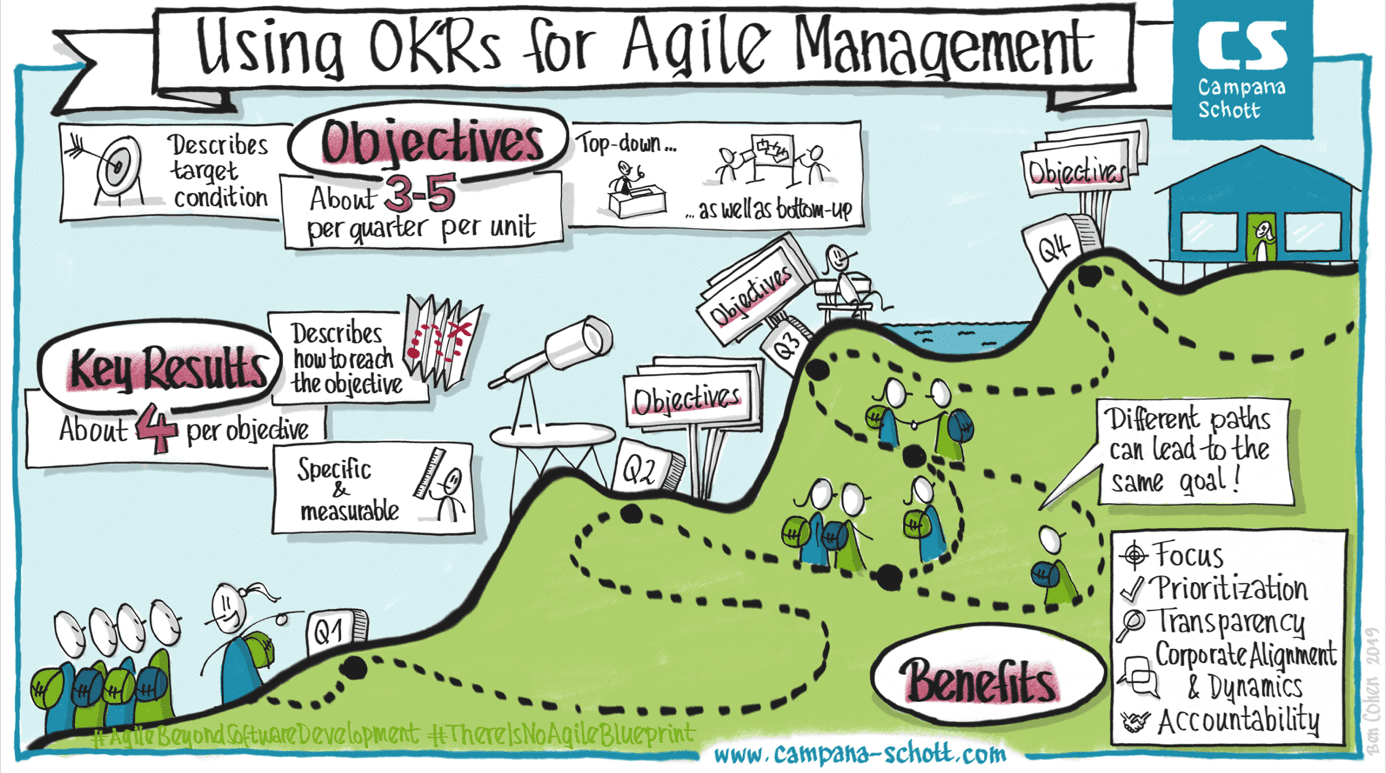The time when companies took years to plan and implement strategies is a thing of the past. Constant changes call proven processes into question. In this context, it is particularly established companies with a proven track record of success that find it difficult to overcome historically grown and successful principles, methods and processes and open themselves up to new and modern approaches. This is also due to the fact that different management levels - because of a desire to maintain the status quo, or for reasons of convenience or uncertainty - prefer to stick to what has worked in the past. The superpowers of the OKR management framework, which has been used mainly by start-ups and tech companies, can also help established industries to quickly adjust objectives and priorities to changing environments without losing sight of the company's vision, mission and strategy.
It is particularly during times of crisis that companies must quickly respond to new requirements and operate as a cohesive unit to remain successful. A chaotic lurching pattern can be avoided when cool heads prevail to formulate new strategic objectives or adapt existing objectives that are subsequently pursued in an efficient manner. In this context, defining the right objectives can already become a challenge for many companies. And so, it becomes even more difficult to ensure the meaningful and transparent development of measures across multiple levels and divisions to achieve the company's objectives.
There are many people who work at the company. But to use a sports analogy, a team needs a common strategy and tactics to achieve the best results or improvements for the team. What this means: Every employee must know which contribution they are supposed to make to help achieve this larger goal. And similar to a sports team, every member will be far happier about winning the tournament than their individual score.
Linking individual goals to team success
But how can employees connect the impact of their action to the concrete strategic objectives of the entire company? Previously, this was achieved with top-down, hierarchical specifications. But constant change, new management styles and an increasingly self-confident workforce require a different approach, which combines top-down with bottom-up.
Fast-growing tech firms recognized these challenges early on, and they moved to try out new management models. In the 1970s, Andy Grove at Intel developed OKR (Objectives & Key Results) on the basis of Management by Objectives, and this approach became very popular at North American software companies starting in the late 1990s. OKR helped these firms pursue their ambitious growth strategies and objectives with a focused approach and enabled them to dynamically adapt to changing external and internal conditions. With the book “Measure what Matters” (John Doerr, 2018), OKR also became accessible to a European audience.

The ideal approach
However, anyone using the OKR concept as a standard solution that is strictly implemented by the book will probably fail - this has been shown in practice. Particularly in the case of established companies with existing management systems, strict adherence to Doerr's book or other standardized OKR frameworks is unlikely to lead to productive solutions. The corresponding consulting concepts must be treated with a certain amount of caution.
A better idea is to adapt the OKR framework to the company's specific requirements, because many established businesses face the following challenges:
- They are not starting from scratch, which means that OKR cannot simply be introduced across the company and regardless of other target systems. For example, many companies already have performance management systems with variable salary components, which must be taken into account.
- Particularly in groups of companies, internal consensus-finding and coordination processes are much more complex than in start-ups, and they include a lot more people and corporate levels.
- The idea of full transparency still has not been embraced by many German companies, employee representatives and works councils.
- The mindset and the courage to use OKR resources to focus on certain issues while leaving aside or deferring other projects is much more pronounced in start-ups than in large corporations.
Experience from numerous projects shows: OKR can be used as a means to implement strategy. But it is primarily a “communication instrument,” a common mindset and language that empowers people in organizations to achieve common goals and results. At the end, the introduction of a management framework (such as OKR) has an enormous impact on the company's culture - with all of the ensuing opportunities and challenges. Therefore, it should be approached with the appropriate respect and seriousness.
The concept works similar to agile project management, but at the management level. There are the main objectives that must be achieved, but the team must also regularly adapt them to reality - inside and outside the organization. Only then does the framework generate added value, gains acceptance and becomes viable.
The superpower of OKR
The greatest advantages of OKR are that they promote company-wide strategic alignment, they steer the focus and resources on the most important issues, and they create transparency and measurability. Exactly which of these “superpowers” will provide the most added value or progress to a company will depend on the organization and the challenges at hand.
For example, the alignment component will bring about the most worthwhile changes if the goal is to ensure that all divisions act in concert in a more structured manner while identifying with the same vision, mission, and concrete objectives (see illustration). If a company faces the challenge of using scarce resources more efficiently, the prioritization of goals and projects using OKR and a consistent focus on the most important or promising issues will generate the most added value. Increased transparency can help companies to better overcome challenges such as internal silos, unidentified dependencies, or the lack of a cross-departmental mindset. Finally, the “superpower” of measurability can be used to create an environment for turning ideals into concrete and verifiable results with real impact.

The manner in which OKR are supposed to be used greatly depends on the company’s specific situation. In some cases, OKR can already produce enormous added value if they are used in a dedicated company division, for example to align the division's targets more closely with the general business strategy, or to increase the focused use of resources.
In other cases, OKR will only develop their full impact if they are implemented across the company in all divisions and at all levels. In cases where companies are about to embark on larger transformation processes or pursue very ambitious growth objectives, OKR can provide the right framework that leads to success. This means that the framework must be adjusted and scaled depending on the starting situation, speed of change, complexity, and the culture of an organization. In every case, this will necessitate the continuous and successful introduction and establishment of change management measures that are tailored to the company, in order to get everyone on board.
The main advantages
A tailored OKR framework allows established companies to generate concrete added value and practical benefits. This has been shown in numerous projects. The main advantages are:
- Management and employees regularly discuss goals, the desired benefits, and the intended results. A clear and common objective has been formulated, which leads to increased identification with the objectives.
- Employees recognize the relevance of their work (purpose), and how individual work activities fit into the bigger picture.
- Transparency about objectives and the associated projects has an enormous positive impact because it reveals potential areas of conflict (e.g., resource bottlenecks or dependencies).
- Repeated iterations and points of contact between employees and the OKRs or the business strategy mean that new experiences can be integrated, and market developments can be addressed at a very early stage.


